PPC
What the Big Tech Layoffs Mean for SMBs & PPC: 8 Key Takeaways

Unless you live under a rock (I can say that because I’ve been known to camp out under a pebble or two), there’s no doubt that you’ve been hearing about one thing in the news lately:
Big Tech layoffs.
Microsoft, Google, Amazon.
It even has its own hashtag #layoffs2023.
Mass layoffs of any kind are unsettling no matter how applicable they are to you, but as a small business owner or marketer, you may have some concerns. Yes, this is “Big” Tech, but does this or will this have any implications for small businesses? Many of these companies are also ad platforms, so will this have any impact on PPC?
I’ve taken a dive into the story from this angle to provide you with some key takeaways. Read on to learn:
- What’s happening in Big Tech?
- Why are all these layoffs happening?
- What does it mean for online advertising and small businesses?
What’s happening in Big Tech?
In January of 2023 we saw more layoffs in the Big Tech sector than in any month since the pandemic. To put things in perspective, there were 159,684 tech job cuts in 2022, but in January of 2023 alone, we saw 68,502. That’s more than 43% of what we saw in all of last year.

Companies that have conducted mass layoffs in January and recent months include Google, Microsoft, Informatica Salesforce, Amazon, SAP, IBM, Spotify, Wayfair, Coinbase, and Vox Media.
As mentioned earlier, mass layoffs innately are concerning, but the reason why this situation is of particular interest is that not only is it unexpected, but it’s also being called one of the worst contractions in the industry’s history.
And it’s also a little peculiar when you look at it in relation to the labor market. As The Atlantic writer Derek Thompson points out:
- During the 2010s, the labor market was weak but the tech sector was growing.
- During the pandemic, the economy had a “flash freeze depression” while tech took off.
- Today, the labor market is strong but tech is “bleeding.”
So what’s going on here?
Why are all these layoffs happening?
There are multiple factors at play, which Derek’s article does a great job covering. Here’s the rundown:
The expected tech “acceleration” from the pandemic turned out to really just be a “bubble.”
Tech companies, consumers, and investors alike all subscribed to the notion that the surge in remote work, ecommerce, and other online platforms during the pandemic put us on the fast track to the 2030s. But this has not been the case. We never made it there; we’re still just on our way and we’re settling back into the same speed of travel as in 2019. As a result, all of that expansion and investing now is in excess. Hence the contraction.
Inflation caused an advertising slump
Keep in mind that many of these tech companies—Google, Meta, Amazon, etc.— are also advertising platforms. And with inflation reaching its highest levels in 40 years in 2022, many businesses pulled back on advertising as this is often one of the first areas to see cuts during a shaky economy—not to mention the fact that advertising costs increased along with everything else.
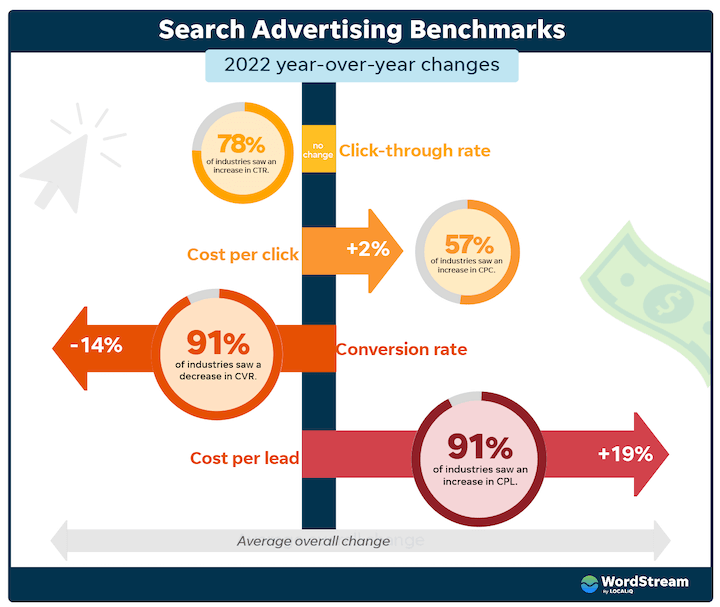
Companies are preparing and adjusting
For some companies, the layoffs are happening also as a proactive measure. While inflation appears to be on the mend (it has dropped from 9% to 6.5%), economists, and therefore businesses and consumers are still wary of a recession. If these companies want to maintain profitability and to send the right message to shareholders, they need to prepare for businesses and consumers to continue cutting back on spend even in the new year—which means cutting back on spending themselves.
Of course there are spinoff theories and schools of thought, but these are the core reasons you’ll find woven throughout any coverage on the matter.
What does it mean for small businesses and PPC?
Alright, so now that you have a grasp on what’s happening and why, let’s talk about what this means for small businesses and PPC according to news articles, last week’s PPC chat discussion, and the very PPC experts who contribute to our blog! Here are some key takeaways that feel particularly pertinent:
1. Big tech is not at risk
“Revenue decline” doesn’t necessarily mean that any of these businesses are failing or on their way out. Remember, these aren’t just businesses, they are behemoths. And as Tech Reporter Bobby Allyn’s NPR article cited earlier states, while these changes are historic, they’re still small on a percentage basis.
These companies are still massively wealthy and Big Tech has been on a strong growth trajectory for the past ten years. Microsoft alone made $198 billion in revenue in 2022.
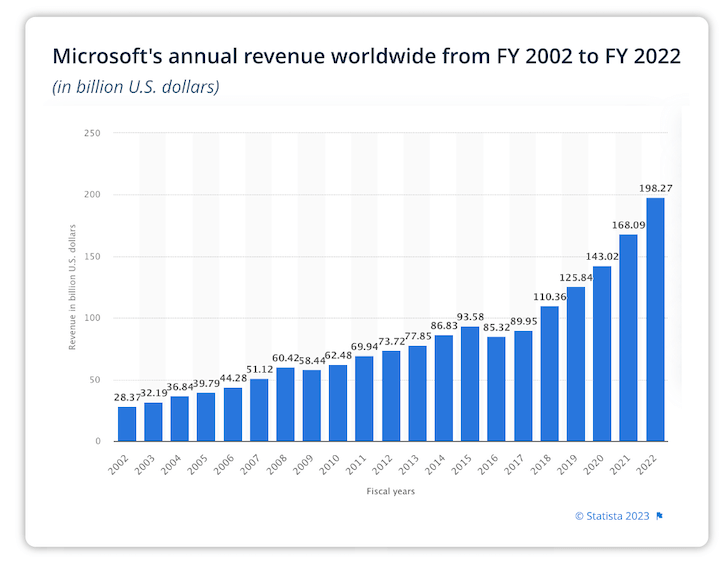
These measures aren’t a sign that they’re on the brink of disappearance, but rather course correction in accordance with the post-pandemic story as it unfolds, to get back on that growth trajectory.
2. This is only temporary; digital advertising will still grow
Given the above, it’s not surprising that many PPCers feel this is only temporary and aren’t concerned about there being a further economic downturn or ripple effect on small businesses or advertising in general.
Take digital marketing strategist, author, and speaker Anders Hjorth’s Tweet in #PPCChat, for example:
A1: We have been on a shaky ride since Covid. I think the big platforms got overoptimistic and wanted to come out top on the talent battle.
We are now going through a readjustment but it doesn’t change the baseline for growth in digital advertising.
This is temporary#ppcchat— Anders Hjorth (@soanders) January 24, 2023
We also asked Brett McHale, founder of Empiric Marketing, LLC and regular WordStream contributor for his take on the matter and he shared the same sentiment:
“We have seen economic downturns and mass layoff lead to eventual booms/bubbles—what comes to mind is the 2008 economic crisis that eventually gave way to the tech boom of the 2010s. I’m not necessarily saying that is what is going to happen now, just that these economic situations tend to have a cyclical nature to them.”
It’s worth noting also that no one expressed concerns about any one platform in particular other than Twitter, for obvious reasons.
3. It could open up new opportunities
Another perspective that many PPC influencers and practitioners share is that with so many talented people out of work and with time on their hands, there is potential for new opportunities or movements to happen. Paid search manager Sarah Steman Tweeted in #PPCChat:
A1: Yes, tech is full of opportunity and when you have this volume of highly qualified people out of work there is a shift, however I also see job loss as opportunity for creation and new ideas sometimes people feel free to explore passions or start a business. #ppcchat
— Sarah Stemen (@runnerkik) January 24, 2023
Mark Irvine, Director of Paid Media at Search Lab Digital and regular WordStream contributor (and former Streamer!), shared this viewpoint:
“The biggest piece to think of is that there are tens of thousands of people with top-quality talent reentering the industry who have years of experience working with large numbers of clients and varied budgets. They’re also well-versed in their former company’s tools and features and have unique insight into the industry from their past roles that many of us don’t have exposure to.”
4. We may see more small consultancies open up
Brett also sees new opportunities arising, more small consultancies in particular:
“I can see many talented professionals in the space making the transition from big brands to independent contract work. Taking on a W2 employee is a massive risk for a company whereas a 1099 employee is a much lower risk, both financially and legally. Talented folks who have lost their jobs might source their talent to multiple companies to create several sources of income for themselves and handle their own health benefits under their own LLCs. “
Navah Hopkins, Brand Evangelist at Optmyzr, regular WordStream contributor (and also former Streamer!) Navah Hopkins expressed the same:
“On a personal note, I often questioned whether I made a mistake not going for one of the big brands. When the layoffs happened, it cemented for me and many other digital marketers like me that we can thrive without “big brand safety.” I’m excited to see the rise of consultants and taking lessons learned to verticals that didn’t have access to the amazing talent now on the market.”
5. Agencies and large resellers have the most to gain
Another outcome we may see, Mark pointed out, is an influx of new talent to agencies and resellers. Here’s what he had to say:
“Agencies and large resellers likely have the most to gain from this shuffle. Compared to small businesses, they’re in the best position to attract this new talent that has experience working across a large portfolio of clients. Additionally, Google’s most recent announcement is that of reembracing its partners, specifically resellers to enable more advertisers to grow on their platforms.”
Resellers mentioned in the article include Accenture, Interactive, Incubeta, Jellyfish, and Media.Monks.
One potential concern that many PPCers agreed on was that with revenue in greater focus, ad platforms may start pushing features and upsells more so than genuinely helping advertisers succeed. This wouldn’t be a novel concept by any means (Google Ads automation anyone?), but it will be important to be extra vigilant, especially if you’re a beginner advertiser.
PPC influencer Robert Brady expresses this concern in his Tweet:
A1: The layoffs suck for the people involved. Hard stop.
I also don’t like how it signals from the platforms that they’re focusing more on the bottom line. There area lot of levers they can pull in their algos to generate revenue at advertisers’ expense. #ppcchat
— Robert Brady (@robert_brady) January 24, 2023
He also followed that up with:
And I feel like reps will be even more insistent on pushing features that help the platform and not advertisers. @robert_brady
Mark shared the same viewpoint:
“I’m going to be increasingly skeptical of new products released over the next ~120 days. Layoff rounds right before an earnings call is not coincidental. Product announcements aren’t coincidental either. There’s still lots of great teams at these companies that are making great things, but following a round of layoffs, a product manager isn’t going to boldly recommend that they push back their new anticipated tool for another quarter or two because it’s not ready. Implicit or not, many teams will feel the pressure to produce “quickly now” rather than “correctly later.” I would be extra skeptical of anything announced or anticipated before big days for their investors in April or July. Looking at you, GA4.”
Another concern is that we could see a degradation in customer support or more outages. In fact, Google Ads was out for three hours on January 23. This issue has been resolved. Thank you for your patience and we apologize for the inconvenience. https://t.co/0AqTKCl6Ts
— AdsLiaison (@adsliaison) January 23, 2023
Many agree that support is already lacking so this could be a pain point. Navah notes that these brands will be under higher scrutiny:
“The brands doing the letting go will be under more scrutiny than ever before. I suspect true return on investment with any of these platforms (Google, Microsoft, Amazon), as well as less patience for substandard service will be the main themes of higher churn for their customers. Many of us noted that it was odd Google Ads went down hours after the layoffs, and instances like these might become more common, and the industry will have less patience for it.”
Mark comments on this final concern (as if ad disapprovals weren’t already a pain point):
Unfortunately, I agree that traditional “cost centers” like customer support are going to be pulled from first. Particularly given the recent successes in AI like ChatGPT, it’s increasingly tempting to push AI in these areas.
However, I’m also worried that there’s temptation to pull away from areas like moderation or policy enforcement. Google has increasingly automated its policy enforcement over the past few years, to poorer results, and I imagine this will continue. Twitter sets a dangerous precedent in eliminating its moderation teams and I think that lowered bar makes for poor incentives for other tech giants to dedicate resources to important non-revenue generating teams.”
While I hope that companies continue to reinvest in their values, even things ensuring advertisers only pay for quality traffic and filter out invalid traffic are troubling. When no one is watching, are these tech companies going to improve or maintain their standards, or are they going to be tempted to water down that wine and charge advertisers for more traffic to influence their bottom line?”
If you haven’t been quite sure about how what’s going on with all of these Big Tech layoffs, my hope is that this article has demystified some of that for you. And as far as how you should be feeling, I’d say that a little concern is good, but panic? Not necessary. The experts and veterans in the industry aren’t taking any drastic measures. The idea is, as Ashton Clarke Tweeted to “help clients keep a level head and maintain stability.”
So long as you stay on top of the storyline, keep an eye on your metrics, and make PPC decisions based on data, not automated recommendations, your account and performance will stay in good shape!
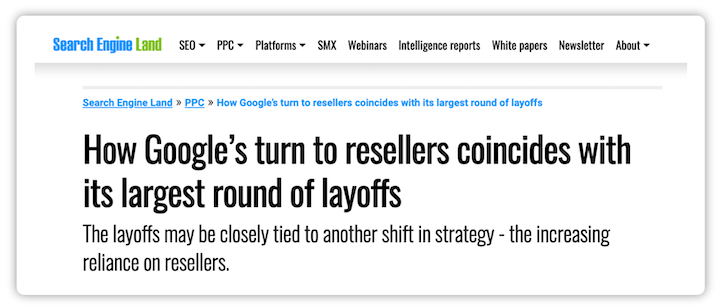
6. Advertisers need to be on guard
7. Be prepared for outages and/or gaps in support
8. Moderation and policy enforcement could suffer as well
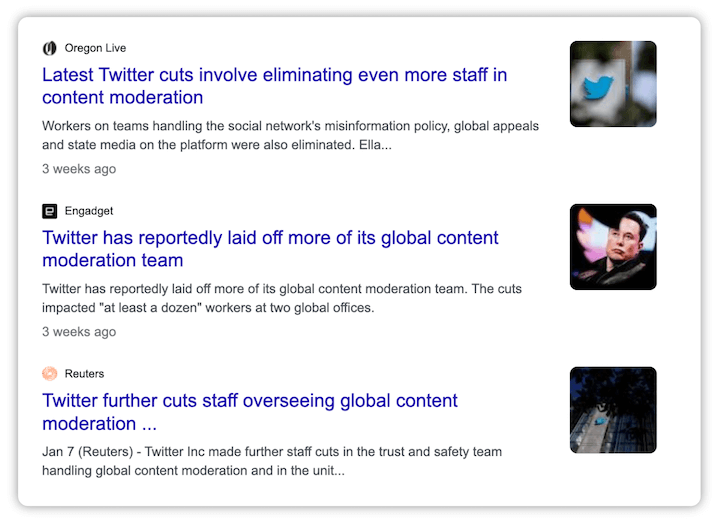
So what’s the verdict?
PPC
Low Risk, High Reward YouTube Ads alexking

Do you want to introduce your client to YouTube ads but thought it was too high risk?
Have you thought about diversifying your marketing channels and want to know how to launch on YouTube with minimal risk?
You’re not alone. More and more advertisers have either spotted the potential of YouTube or want to add to their existing profitable channels. Unfortunately a significant number have subsequently retreated after seeing poor initial results.
The lowest risk way to get results with YouTube ads (and possibly the highest return), is with YouTube placement targeting.
By serving your ads on specific YouTube videos or channels that are a perfect match for your product or service, you minimize wasted impressions on an irrelevant audience. In turn you maximize your return on ad spend.
The Pyramid Targeting Technique: A Strategic Framework
As part of my “Pyramid Targeting Technique” model for profitable YouTube ad campaigns, placement targeting sits at the top.
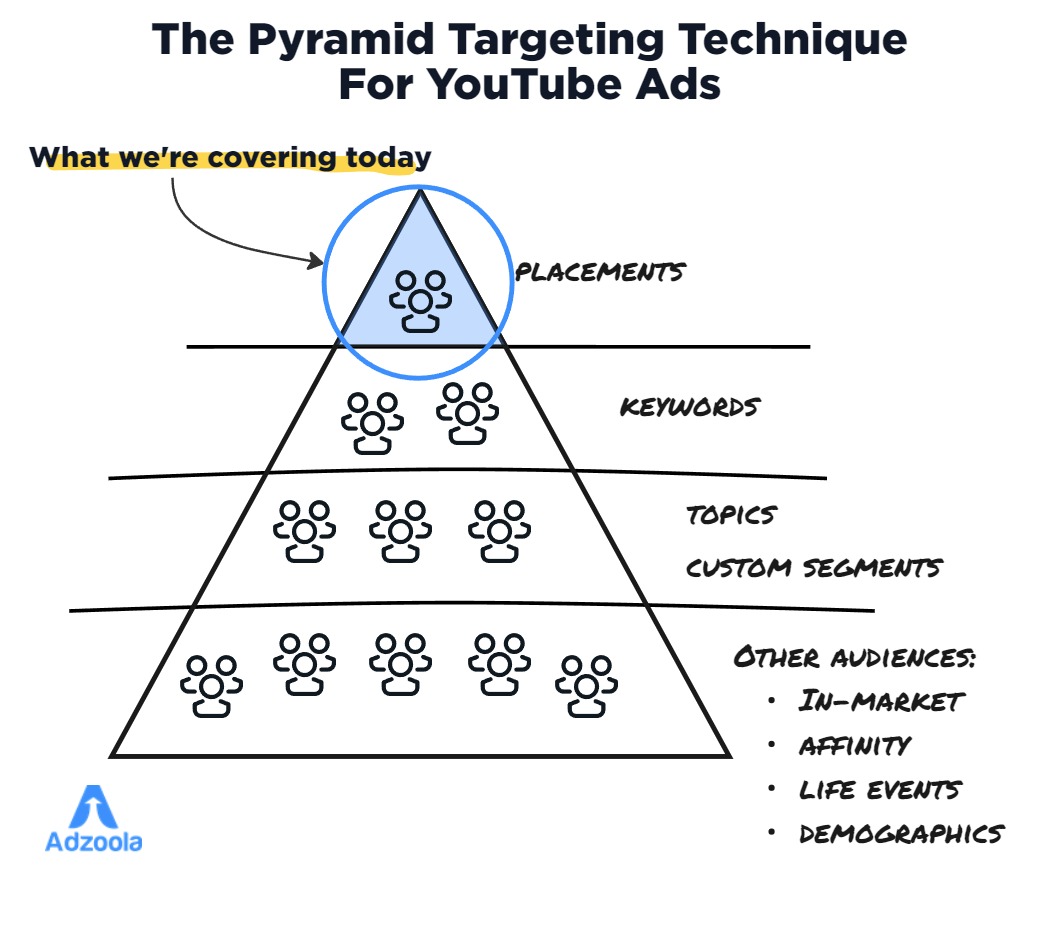
This laser-focused method allows you to hand-pick exactly where your ads will be displayed – giving you unrivaled control.
Here’s why you’ll want to start with YouTube’s placement targeting:
1. Profit-Producing ROI Potential
With tight audience targeting you’re putting your ads directly in front of a highly relevant, interested crowd. This precision-striking ability maximizes your chances of driving conversions by meeting their intent with your message.
2. Small Budget, Big Results
Since you can start with a small number of placements, placement targeting is ideal for affordably testing different ads and messages without blowing your budget. Find your winners first, then scale up (working your way down the pyramid).
3. You’re the Master of Your Audience
You choose the specific videos and channels to run your ads on, rather than relying on Google’s algorithms to figure out relevancy and serve your ads. This granular control helps ensure your ads stay hyper-focused on your prime prospects.
With such a narrow targeting method, audience sizes will naturally be smaller than broader methods like keywords, topics, custom segments and interests. But that’s the advantage – you can consistently put your brand in front of an audience you know have intent and interest at the moment you’re reaching them.
Placement Pitfalls to Avoid & Quick-Fire Tips
Placement targeting isn’t always a magic bullet. Advertisers often struggle with a few common pitfalls that sabotage their results. These will help you avoid being one of those who say “I tried, it doesn’t work” or “It won’t get conversions”.
1. Bidding Too Low
Given placement targeting is the most precise form of targeting on YouTube, it often requires higher bids to effectively compete in the auction. In practice, many advertisers pay less than their maximum bid due to the auction dynamics. Remember, you’re targeting an ultra-focused audience – it’s worth paying for that privilege.
2. Overly Restrictive Layered Targeting
Combining placement targeting with too many additional targeting restrictions, such as narrow age or geographical limits, can overly constrict the audience size and hinder performance. A light touch is often best.
3. Manual Optimization Neglect
Some advertisers struggle with high cost-per-acquisition (CPA) on placement campaigns. Often they haven’t engaged in regular manual optimizations. As it’s a manual campaign you’ve got to review and optimize regularly.
4. Misusing as a Scale Tool
While extremely powerful, placement targeting simply won’t reach the same stratospheric audience levels available on YouTube as broader methods. Use it as an intelligent testing bed and build scale with other targeting methods (further down the pyramid).
5. Keep your video and channel placements in different campaigns for easier management and optimization.
Keep your video and channel placements in different campaigns for easier management and optimization.
6. Mixing Videos and Channels
Keep your video and channel placements in different campaigns for easier management and optimization.
7. Path of Least Resistance
When starting out, it’s often easier to find well-performing individual video level placements rather than channel placements. Build from that base.
Setting Up YouTube Placements
To set up your YouTube ad campaign targeting placements, you’ll start by selecting ‘create a campaign without a Goal’s guidance’, then choose the Video campaign.

You can use placement targeting (and the other content targeting options) in four video campaign subtypes:
- Video Views – using Max CPV, Target CPV (with Multi-format ads enabled)
- Efficient Reach – using Target CPM
- Non-skippable – using Target CPM
- Audio – using Target CPM
I’d suggest starting with the Video Views Campaign (VVC) subtype if you’re running a direct-response style ad because you can use Maximum CPV (cost per view) bidding.
For in-stream skippable ads, you’ll only pay when someone watches your ad for 30 seconds or more (or watches the full video if it’s less than 30 seconds.) This is saves you money when you’re launching a new client or starting to advertise on YouTube, as it lowers your risk. You’ve chosen specific relevant videos or channels to show your ad on and you only pay when someone chooses not to skip in the first 30 seconds.
So select Video Views as the campaign subtype:

During setup it’s critical that you go to Network settings and uncheck ‘Video partners on the Google Display Network’. It’s easy to forget but it’ll cost you if you do. If you have this checked Google can (and often will) show your video ad on the Display Network, even if you only add placements to your targeting.

Scroll down and you’ll see the Content targeting options – keywords, topics and placements. Select Placements and navigate to ‘Enter’ so you can add your placements.
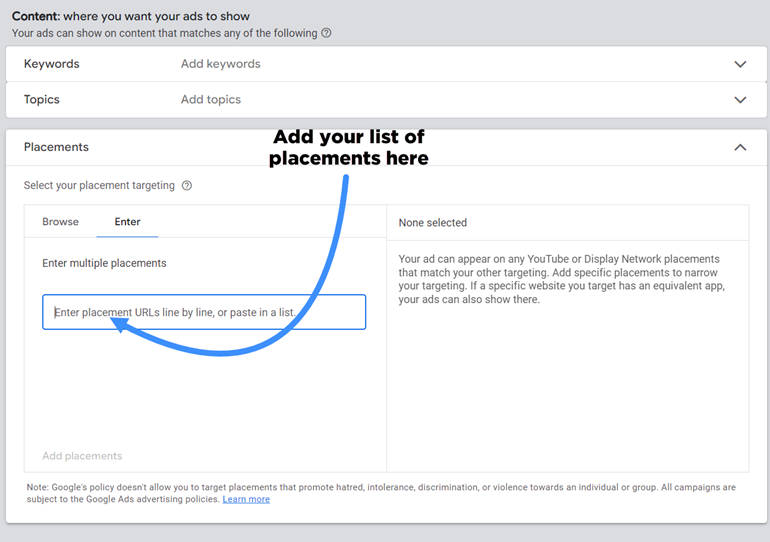
Don’t move on until you’ve actually clicked ‘Add X placements’, otherwise your placements won’t be added. I know it sounds obvious but I’ve seen cases where this has happened. It’s horrible having to tell someone they didn’t actually add the placements and the campaign has been spending that way for a while!
You can use research tools like my own, Adzoola, to find, filter and add video or channel placements to run focused campaigns to a relevant audience.
Test a handful of promising placements, analyze the results, then either maximize the winners or restart your sourcing process.

Don’t Sleep on Placements: The Low-Risk Testing Bed
For advertisers looking to maximize ROI from their YouTube ad spend – especially those operating with smaller budgets – placement targeting needs to be a core part of your strategy. The ability to put your brand and messaging in front of an ultra-relevant audience in a cost-effective manner is a game-changing advantage.
While placement targeting may require more manual management than automated campaigns, having that level of hands-on control could be the key to cracking profitable YouTube advertising for your brand and offering.
The Next Level: Scaling Up with the Pyramid
While placement targeting represents the pinnacle of precise YouTube audience targeting, it’s just the first step of a bigger picture strategy.
The Pyramid Targeting Technique is one of the frameworks I teach in my YouTube ads training course to strategically plan, manage, and scale YouTube ad campaigns. It’s designed to guide you along a path to profitable YouTube ads with less risk.
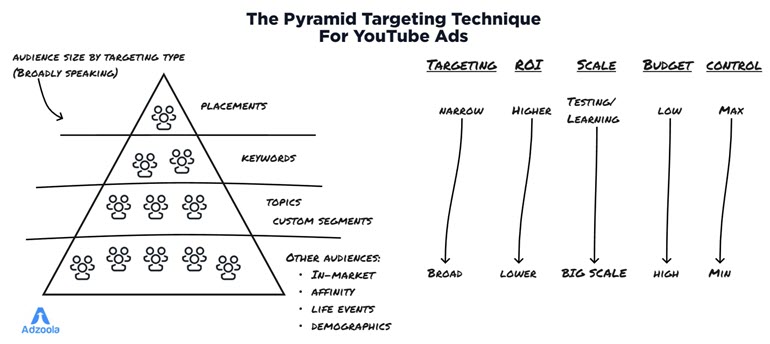
By following the Pyramid Targeting Technique and launching with focused placements, you minimize your upfront risk with lower budgets and maximum control. Once you’ve worked out your winning formula through this testing bed, you can scale your budget and expand targeting incrementally down the pyramid.
And, you can use it at almost any budget level.
If you’re a larger brand with a bigger budget and higher risk tolerance, you can skip levels of the pyramid entirely. Depending on your ability and willingness to go negative on profitability for a period, bigger players can take a more aggressive approach right away.
But for agencies, consultants and small-to-medium businesses, mastering YouTube placement targeting could be the safest and smartest first step for you.
Each successive level down the pyramid represents increased potential scale, but also becomes more hands-off and reliant on Google’s algorithms to optimize targeting. That’s why it’s so crucial for you to get your offering and messaging finely tuned and validated at the more controllable levels like placements first.
The pyramid provides you with a strategic framework to decide the appropriate starting point and level of risk based on your specific circumstances, risk tolerance and ultimate goals. The choice is yours, but this profitable, proven path is clearly mapped for you to follow.
Alex King is the founder of Adzoola and a YouTube ads specialist with over 14 years of media buying experience.
PPC
Google Shopping: A Beginner’s Guide to Crafting a Compelling Campaign Google Shopping: A Beginner’s Guide to Crafting a Compelling Campaign

With all the tools available online, there’s no limit to how you can advertise your eCommerce brand to consumers. With over 12-24 million eCommerce websites across the globe, what matters is how well you leverage these tools to help your business stand out from competitors.
There’s no better way to boost your online presence than with Google, responsible for handling nearly 8.5 billion queries each day. Google’s intuitive marketing tools, such as Google Ads, are trusted by more than 7 million marketers worldwide. If you’re running an eCommerce website, however, you need to be using Google Shopping Ads.
What are Google Shopping Ads?
Launched in 2012, Google Shopping is designed to help online retailers showcase their products visually. If you’ve ever gone looking for a particular item on Google, chances are you’ve come across them at the top of the search results page, lined up horizontally. There’ll be an image, product description, price, and store name. These are Google Shopping Ads.
Google Shopping Ads vs. Google Search
Google Ads and Google Shopping Ads serve different purposes. Google Shopping Ads are essentially product listing ads that help consumers easily learn about a product and where exactly to purchase them. Google Ads (or Google Search Ads) are text-based, relying heavily on copy, while Shopping Ads include images. Google Ads have a much broader scope since you can advertise anything using them, whether they be products or services. Google Shopping Ads can only be used to promote specific products.
The Benefits of Google Shopping Ads
Since Google Shopping Ads are typically displayed at the very top of search results pages, they will be the first thing consumers see when they search for products. This means increased brand visibility for online stores. By the same token, this type of ad can also help retailers reach out to a more specific demographic.
Since Google Shopping Ads collect product information, they can directly target the right audience for your line of business. Studies have also found that Google Shopping Ads achieve 30% higher conversions compared to traditional text-based ads, therefore ensuring better ROI.
4 Ways to Make Google Shopping Ads Work for your Online Business
Having explored the history and advantages of Google Shopping Ads, let’s dive into how you can include them in your eCommerce marketing plan to help you achieve online success:
1. Prioritize Product Feed
When creating Google Shopping Ads for your online store, it is imperative to include key information about your products. Google Shopping Ads highlight product names, images, descriptions, and categories – all of which are vital to your customers being able to find your products easily. For your product titles and descriptions, you may incorporate keywords that can make it a whole lot easier to search for specific items. Using appealing and high-resolution product images can give your website a boost in terms of click-through rates. Don’t forget to include prices.
2. Leverage Customer Reviews
When you look through Google Shopping Ads, you may notice some of them have star ratings. This is because Google allows retailers to display customer reviews in their ads to help promote their products. Studies have found time and time again that 93% of consumers check product reviews before proceeding with their purchases. Posting customer reviews can aid customers in making informed decisions and show them that your brand is trustworthy.
3. Optimize Campaign Structure and Product Groups
To see improve your ROI, you can try optimizing your campaign structure. This helps you manage your campaigns easily since it involves organizing certain aspects of your business such as product types and target customers. Organizing your products by categories can also help the Google algorithm accurately find the right items shoppers are looking for.
All you have to do is simply create different ad groups for different products. For example, if you’re running a clothing store, you can make a specific ad group solely for a specific kind of pants and aim them toward shoppers who are in need of this particular product. This will help your ads drive higher conversion rates and sales since they will only be seen by those who are interested in them.
4. Add Negative Keywords
As with search, one of the many features included in Google Shopping Ads involves the use of negative keywords. Negative keywords are phrases that prevent search algorithms from displaying results that are unrelated or irrelevant to what people are actually looking for. This feature increases search accuracy and makes it way easier for shoppers to find your products.
5. Categorize Ads By Demographics
Whether you wish to expand your reach or target a specific audience, it would be wise to organize your ads according to demographics. Collect pertinent customer data such as location, gender, age, shopping habits, interests, and frequent searches – this information can help you best determine what type of ads your audience will be inclined to engage with. Once you have these details, you can effortlessly target your ideal audience and promote your products among them.
6. Adjust your Bidding Strategy
Since you’re investing resources into creating your ads, it’s important to determine how much you’re actually willing to pay for them. If you’re able to maximize your Google Ads bidding strategies, you can help your brand rank better in search results. Here are some of the popular bidding strategies you can give a try:
- Target Cost Per Action (CPA) – for improving conversions by targeting a specific CPA
- Target Return On Ad Spend (ROAS) – for improving conversions by targeting a specific ROAS
- Maximize Conversion Value – for optimizing conversion value without targeting ROAS
- Maximize Conversions -or optimizing conversion value without targeting CPA
- Maximize Enhanced Cost Per Click (ECPC) – for automatically adjusting manual bids
PPC
How the TikTok Algorithm Works in 2024 (+9 Ways to Go Viral)

If you post videos and want more people to spend more time watching them, then you and TikTok have a common goal. That’s why I cringe a bit when I see people talking about hacking the TikTok algorithm for more likes and views.
You don’t need to trick it; you just need to know how the TikTok algorithm works. Once you understand its basic principles, you’ll know what and when to post for your best shot at TikTok virality.
But what about the potential US TikTok ban? TikTok has 148 million active users in the US. To paraphrase Samual L. Jackson’s character Nick Fury in Marvel’s Avengers, “Until such time as the world TikTok ends, we will act as though it intends to spin on.”
Let’s get into the weeds of TikTok’s algorithm, see how it suggests videos to individual users, and find ways to get your content on more viewers’ screens.
Contents
What is the TikTok algorithm?
The TikTok algorithm is a recommendation engine that decides which videos to suggest to each individual user.
On TikTok, recommended videos appear on your For You Page (FYP) when you first open the app.
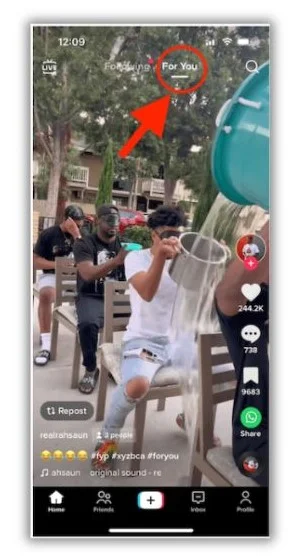
Everyone’s For You feed is unique and will change over time. TikTok pays attention to the videos you watch, where you post comments, and the accounts you follow. Each interaction is another signal the algorithm uses to refine your FYP—showing videos you’ll probably like while keeping videos you won’t off your feed.
💡 Want to grow all of your marketing channels? Download The Best Online Marketing Tips for Generating More Traffic, Leads, & Sales to get over 100 actionable growth marketing tactics.
How does the TikTok Algorithm work in 2024?
If you’ve ever sent your friend a cake recipe link because you remembered they love to bake, you get the gist of how the TikTok algorithm works.
Of course, TikTok’s proprietary algorithm is infinitely more complex than yours (no insult intended). It analyzes thousands of signals to determine which videos belong on your FYP. Let’s look at a few of the most influential ranking factors.
Factors TikTok uses to rank content
We’ll probably never know what every TikTok ranking factor is, but thanks to this post from TikTok itself, we do have an idea of a few ranking categories.
User interactions
Your behavior in the TikTok app is the most influential signal for the algorithm. Whenever you like a video or follow a particular account, TikTok uses that to understand your preferences further.
These are some of the user interaction signals TikTok will track:
- Watching full videos
- Following or hiding accounts
- Liking or sharing videos
- Commenting
- Reporting a video as inappropriate
- Adding videos to favorites
TikTok also uses what you say you are and aren’t interested in when you first join the app to guide its suggestions.
Other users’ interactions on a video can also determine whether you get it on your feed. If many people who share your interests watch and like a post, there’s a bigger chance you’ll see it, too.
Video information
On the flip side of the equation, TikTok reviews certain characteristics of the videos you’ve interacted with to see how they match your preferences. That’s important for creators to know since these are the things we have the most control over.
Here are a few of the video and post characteristics the algorithm looks for:
I’ll go into how to optimize your videos for TikTok marketing using these characteristics in a bit.
Device and settings
Device and settings are also user-specific actions the algorithm uses to recommend content. If you’re registered as a US user, you’ll see a lot more content made in the USA. But unlike user interactions, these are one-time signals that don’t typically change over time.
A few device and setting signals that may nudge the TikTok algorithm include:
- Language setting
- Country setting
- Device type
TikTok factor weighting
TikTok’s algorithm weights ranking factors based on how directly they indicate viewer preferences. Direct user actions, like watching a full video, carry much more influence than geographic location.
This means that while it’s good to be aware of all the ranking factors, your focus should be on posting content that your audience will want to watch and share.
Factors that don’t help (and could hurt) your content ranking
In its post, TikTok says it won’t give creators a boost based on past performance. Someone with a high follower count and previously viral videos won’t get preferential rankings over a smaller account with more relevant content.
Additionally, there are some types of content that TikTok will de-rank (show less or not at all) in your FYP. These include:
- Videos you’ve already seen
- Content that’s considered spam
- Duplicated content (like a second post of the same video)
- Videos with restricted content (like graphic medical procedures)
To be clear, some of this content will still be available if you search for it. It just won’t pop on your FYP.
How to reset the TikTok algorithm
TikTok’s algorithm finds the type of content you’ll love based mainly on what you’ve enjoyed in the past. Sometimes, the recommendations don’t keep up with your changing preferences, and your feed gets stale.
TikTok has built a way for you to scrub its algorithm so it starts from scratch. Then, your interactions moving forward will influence the content you get on your personal FYP.
Here are the steps to refresh your FYP:
- Open the TikTok app and tap “Profile”
- Go to the menu at the top and choose “Settings and privacy”
- Tap “Content preferences”
- Tap “Refresh your For You feed”
- Tap “Continue” and “Continue” again
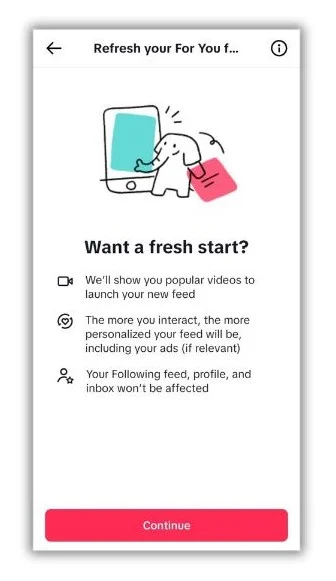

You can’t go back once you finish the process. But only your FYP will be affected. Your “Following” feed and profile won’t change.
📣 Free guide >>> 135 of the Best Words & Phrases for Marketing With Emotion
9 ways to use the TikTok algorithm to your advantage
Knowing how the TikTok algorithm works is half the battle. The other half is publishing engaging content that makes it easy for TikTok to find, categorize, and suggest your posts.
1. Hook viewers quickly
You have a fleeting second or two to grab a viewer’s attention and convince them to watch your video. Keep their thumbs from scrolling by adding an attention-grabbing hook that’s relevant to your audience.
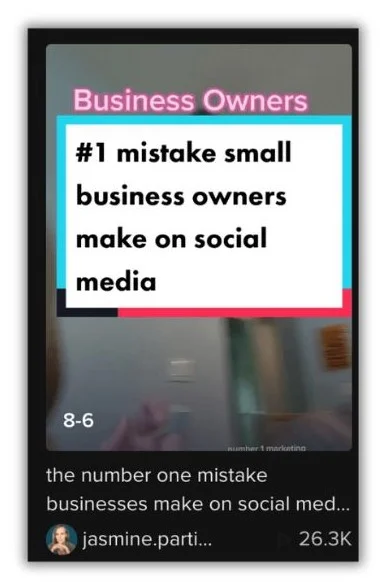

A great hook should give the viewer just enough information to make them want more. Try these tactics for your video hooks:
- Make a bold claim
- Ask a question
- Share a surprising fact
- Hint at a secret
Make sure each hook is relevant to your audience, and use emotional words to catch their attention.
2. Create niche content
It’s hard to gain footing with very popular topics on TikTok since many creators are already fighting for precious FYP placement. However, you can use the algorithm to your benefit by finding niche topics to post about.
For example, cooking is a super popular topic on TikTok. There are plenty of accounts dedicated to whipping up the best dishes. But Bobby Hicks of @theretrorecipekitchen uses his account to trial dishes from days of old. Many of the recipes he tests look tasty, while others look like…a veggie gelatin stack?
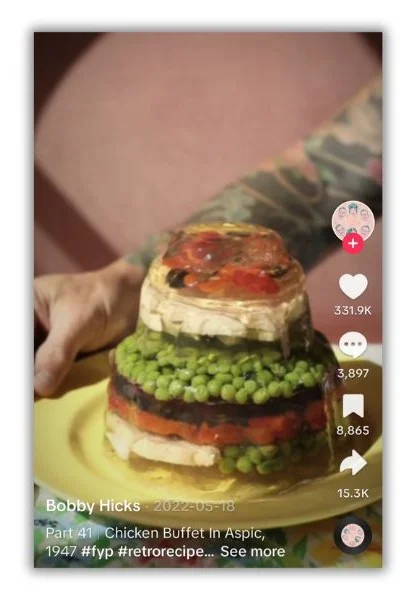

It may seem a little odd, but by focusing on one corner of a popular topic, Hicks has grown his account to over 150k followers.
Review the topics you’d like to use, and if they seem a little crowded, find a subtopic your audience would appreciate. That’ll leave you with fewer competitors in the race for the FYP. It’ll also make your content more relevant to a specific audience, which the algorithm loves.
3. Use TikTok SEO
Search engine optimization isn’t just for Google. Pretty much any time there’s a search function, you can optimize your content for it, and TikTok is no exception. Plus, even Google admits that TikTok is becoming a popular search engine in its own right.
In addition to the other tips in this guide, you’ll want to use keyword research to boost your TikTok SEO. Like on search engines, people use specific words and phrases in the search bar to find content on the app. Your job is to figure out what those words are.
Keyword research is easy on TikTok. Make a list of things your audience might search for that are relevant to your business. If you’re an esthetician, “skin care” might be one of them. Then, enter those words into the TikTok search bar and see what it auto-fills.
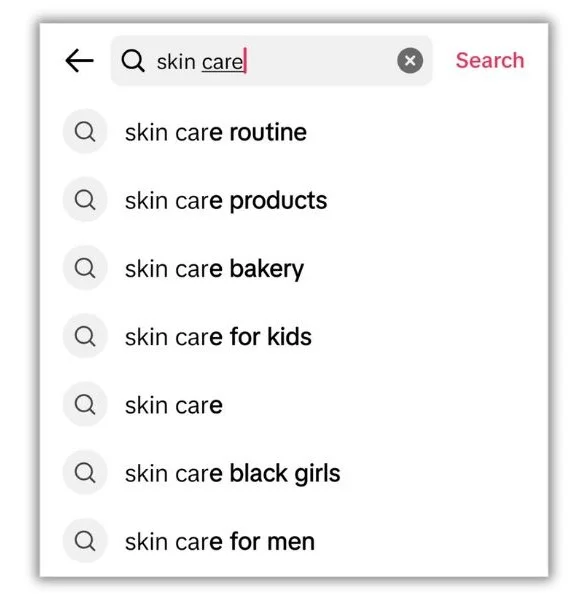

You’ll see options like “skin care for men” and “skin care routine.” Once you’ve gathered a list of keywords, plan out your content calendar to cover each term. Don’t forget to add keywords to your TikTok bio, too.
4. Tailor content to the platform
It’s smart to repurpose content for multiple platforms. But when it’s time to post it on TikTok, make sure it fits the app’s best practices.
First, produce and edit full-screen, vertical videos with a 9:16 ratio. That will fill the entire mobile screen while matching how most people view TikTok content.
Second, keep most of your videos short. While there’s no ideal duration for every video, in 2021, TikTok suggested that the optimal length should be 24 to 31 seconds. The platform has pushed for longer content, but many viewers find videos longer than one minute to be stressful, so it’s safer to keep them under 60 seconds.
Finally, for the best chance of your TikTok videos going viral, keep them positive in tone. Semrush evaluated a large collection of viral TikTok videos and found that those with a positive, funny, or happy vibe did best.
Follow these best practices to get more early engagement, which the algorithm will use as a signal that your video belongs on more FYPs.
5. Post at the right time and frequency
The TikTok algorithm doesn’t really care what time or how often you post—at least not directly. But it does look at how much engagement an individual video gets. Knowing when and how frequently to post can give your videos a little engagement boost.
The right time
The best time to post on TikTok depends on when most of your audience will be on the app. The goal is to publish content a little before the peak potential viewing time to get them indexed and ready for your followers.
You can find that information in your TikTok analytics.


The right frequency
Consistency is essential for success on any social media platform. You don’t want followers to forget about you, and you want more chances to reach new viewers. But how do you quantify “consistency?”
Just like timing, learning how often you should post on TikTok will take some trial and error. TikTok says you should post up to four times per day (of course they do). More realistically, most brands post content to TikTok around two to four times per week (depending on which study you follow).
Here are a few tips to find your perfect TikTok schedule:
- Consider your creative capacity: Posting more often is great, but not at the expense of quality.
- Review other creators: Spy on your competition to see how often successful accounts in your niche post content.
- Watch your analytics: Vary your posting frequency over several weeks and see how it affects your views and engagement.
6. Incorporate hashtags
Using hashtags on TikTok can help you succeed in two ways. First, hashtags help the TikTok algorithm understand your content so it can better match it to user preferences.
Second, TikTok users use hashtags to search for content, so when your video is tagged, it may show up in their search. As we know, when more people see your content, the algorithm will show it to more people with similar interests.
You can find which hashtags are trending in TikTok’s Creative Center.


Here are a few tips for using hashtags on TikTok:
- Don’t use too many: One to four hashtags will usually do the trick without making your post look spammy.
- Use different types: Combine branded, topical, popular, and niche hashtags for the best mix of reach and relevance.
- Include seasonal and holiday hashtags: Adding seasonal hashtags like #hellospring and #Holloweenscares lets you ride the wave of attention during peak times of the year.
7. Add popular audio clips
Audio clips work similarly to hashtags on TikTok. If an audio clip gets popular, and you like videos that use that clip, there’s a greater chance you’ll get more videos with that audio in your FYP.
Head back to the Creative Center to find trending songs.
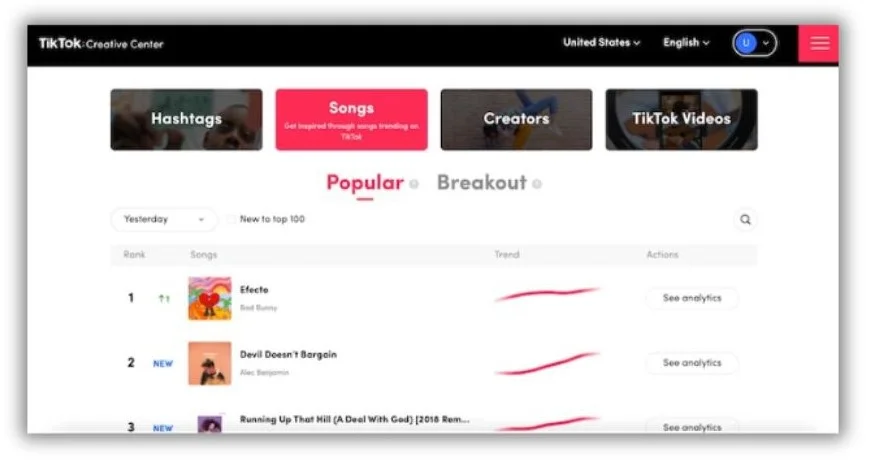

Look in the Popular tab to see which tunes are already getting a lot of play. Then, check out the Breakout tab to catch the next audio wave early.
8. Add captions
Many people don’t watch videos with the sound on. Adding captions to your posts lets those people follow along. But captions don’t just help you appeal to a broader audience. TikTok’s algorithm can learn more about your videos from the text of its caption.
TikTok makes it easy to add captions. Tap the Captions icon, and the app will automatically generate them.


Make sure you use the keywords you dug up in your video script. The algorithm will read those in the captions and know who should see your videos.
9. Jump on trends
One of the best ways to leverage the algorithm to get views is by following TikTok trends. A trend is a theme, idea, or trait of a video that already has mass appeal. That might be a common song or a dance.
Trends can also be challenges, like this one where one person holds another so they look like they’re in the iconic scene from the movie Titanic.


When viewers get hooked on a trend, TikTok sends them more videos to view. If you’ve jumped on the trend, the algorithm will put your video in that mix.
Work with the TikTok algorithm to go viral
The trick to social media marketing is remembering that social platforms want you to succeed. If people love the content you post, they’ll spend more time on the app—which is a win-win for everyone.
The key is learning how the TikTok algorithm works to make it your partner in success. Instead of fighting against the algorithm, find ways to leverage it, and you’ll leap-frog ahead of all the accounts trying to trick or hack it.
Here’s a recap of nine ways you can use TikTok’s algorithm to your advantage:
- Hook viewers quickly
- Create niche content
- Use TikTok SEO
- Tailor content to the platform
- Post at the right time and frequency
- Incorporate hashtags
- Add popular audio clips
- Add captions
- Jump on trends
-

 MARKETING6 days ago
MARKETING6 days agoA Recap of Everything Marketers & Advertisers Need to Know
-

 PPC5 days ago
PPC5 days agoHow the TikTok Algorithm Works in 2024 (+9 Ways to Go Viral)
-

 MARKETING5 days ago
MARKETING5 days agoHow To Protect Your People and Brand
-

 SEO6 days ago
SEO6 days agoBlog Post Checklist: Check All Prior to Hitting “Publish”
-

 SEO4 days ago
SEO4 days agoHow to Use Keywords for SEO: The Complete Beginner’s Guide
-

 SEARCHENGINES6 days ago
SEARCHENGINES6 days agoGoogle Started Enforcing The Site Reputation Abuse Policy
-

 PPC6 days ago
PPC6 days agoHow to Craft Compelling Google Ads for eCommerce
-

 MARKETING5 days ago
MARKETING5 days agoElevating Women in SEO for a More Inclusive Industry














You must be logged in to post a comment Login